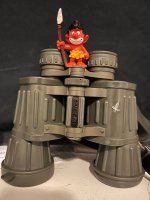My apologies for the delayed reply as I have only just seen the questions you asked.
I am beginning to think I may have a rogue pair as I have hardly ever had any glare (there was one notable exception) in the 7 years I have owned my pair which are 8x30W. Similarly I have found the eye relief fine with glasses (full fov) with the cups folded down. Focus is stiffish but very smooth.
Anyway the following are not measured observations but my estimation by eyeball. They are sharp horizontally for between 80%-90% of the width and then the edges fall away very sharply. Vertically I estimate the sharp area at between 50% and 60% of the height and then fall away gently. For sharp I mean there is no distiguishable difference from the centre. I cannot detect any significant focus error either horizontally or vertically. i.e. if the centre is in focus, all edges are in focus as well.
Thanks for clarifying that. There are owners of the Swaro 8x32 EL that don't see any veiling glare with their samples either even though the false pupils around the exit pupils can be easily photograhped as can the light leaks in the Habicht. So, I suspect that it's not that you have an exceptional sample (if that were the case, I would try to make you an offer you can't refuse, since veiling glare is my biggest reservation). As Tobias described even in a wooded area with sun filtering through, it would create flaring. I had the same experience with the 8x32 EL. It had the best image I've seen though binoculars when it wasn't washed out by glare, which was most of the time.
Some people are more suseptible to chromatic aberration or rolling ball than others, but how someone could see veiling glare only once in seven years in binoculars notorious for it is puzzling. Perhaps because you use eyeglasses puts your eyes closer to the EPs and avoids the false pupils. It's also unusual that 12mm ER is enough to see the full FOV for eyeglass wearers. Most eyeglass wearers need 15-16mm useable ER to see the full FOV. You must have eyeglasses that sit very close to your eyes.
And you can see the image sharp to 80%-90% puts them right up there with the 8x32 EL, which was sharp to 90%, but in a circle, which again makes me wonder why Swaro decided to push it farther with lowering the distortion, which made more problems that it was worth (and created a small ring of blurriness, so in the end, you still only got 90% total). Of course, in bright sunlight with a constricted pupil, field curvature will be less noticeable.
All I can say is that Bino Gods have blessed you with everything you need to enjoy the 8x30 Habicht without having to make all the modifications Tobias did to enjoy the view. I'm that way with the Nikon 8x32 SE. A lot of people can't use it due to spherical aberration of the exit pupil causing kidney beaning, but I have no problems with that, probably due to my high-bridged nose, which doesn't let me get too close to the EPs. I can even use the SE with shorter E2 eyecups and see the field stop more comfortably, though I need to be careful not to tilt the bins horizontally to avoid image blackouts, which even then are fleeting.
So, different facial features are one explanation why some people can use particular bins and others can not. If I could see what you do through the Habichts I would definitely buy a pair since I'm a porro lover, and new samples have the latest Swaro AR coatings as did the 8x32 EL I had, which was also super sharp, had great contrast, and accurate colors, so I have an idea of what the view would be like with added 3-D effect. Amazing!
Can't afford to buy one right now, but I want to at least try a pair to find out why it's a "cult classic." I will inquire if either the Lost Creek Shoe Shop or Honey Creek Bill & Beak, two optics stores that carry Swaros, has a pair in stock. With Honey Creek, I think they are available only by special order.
Brock









